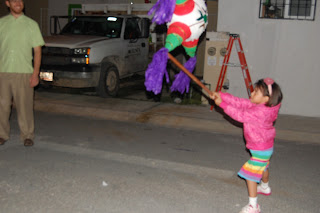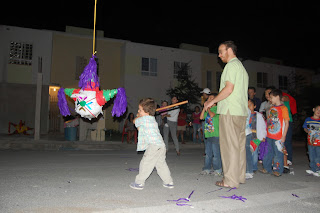 |
| Would your recognize the Virgin Mary? |
This weekend, I participated in my fourth Mexican "posada," which is a communal re-enactment of the scene where Joseph and Mary arrive to Bethlehem and look for a place to stay, which take place during the 9 days before Christmas. The re-enactment is followed by a party where a very traditional hot fruit punch is served to all those who participate, along with snacks, a pinata and other elements of Mexican festivities (=loud music & tequila.)
In the Mexican re-enactment, a group of neighbours and friends from the community get together, light candles, and show up at the door of a the person hosting the party. The people outside with candles play the role of Joseph and Mary (it doesn't matter how many people there are) and the people inside are the innkeeper. The re-enactment is in the form of a song where each "role" sings short verses in response to each.
Joseph asks for a place to stay, the innkeeper sends him away, threatening a beating if doesn't leave. Joseph implores him for the sake of his pregnant wife and finally, 12 verses later, convinces him to let them in. Everyone enters singing joyfully of the night Christ was born. I've been to some (like last night) where a prayer is said, then the punch is served, etc.
Last night I especially noticed Joseph's final method of convincing the innkeeper:
"My wife Mary is Queen of Heaven, and will be the mother of the Word Divine."
The interesting part is actually the innkeeper's response, after so vehemently denying them service:
 |
| The festivities beginning, just after the re-enactment (my posada last night) |
"Are you Joseph? Your wife is Mary? Enter, pilgrims. I did not know!"
If he had only known that it was Joseph and the Virgin Mary! My first reaction to this is probably typical of a more reasonable Northerner; "What a silly little song! As if the innkeeper would've known or cared who Mary was."
Besides no mention of such a dialogue in the Bible, the idea that the innkeeper could've known who Mary the Queen of Heaven was is simply absurd and anachronistic.
But then I had a second thought. From what I understand, these plays are part of a long-standing Catholic tradition of re-enacting the Gospel, still very much alive during Advent and Easter time in Latin America and other some other Catholic areas. On one hand, there's a cultural element here; everyone knows who the Virgin Mary is. I'm guessing that one of the original purposes was to present these key stories to an illiterate population. These re-enactments pull the events out of history and put them into Mexico in the current day and age where it only makes sense that all Joseph would have to do is identify his wife as the Virgin Mary. The recognition of her roles and titles would also serve to teach and reinforce these concepts in addition to the story.
 |
| A Posada (not mine, just a good picture) |
|
Purely for the sake of speculation, there might be something more to this. The idea of "showing what happens" was (and is?) also the main idea behind religious icons, according to Pope Gregory I (6th century) among others. I have also heard the Mass described in a function of "reenactment." Both icons and the Mass show "historical events" in eternal terms, not merely placing the past into the present, but actually showing eternity within the framework of time. (The reason why icons of John the Baptist show him with his head firmly attached to his shoulders, but also holding his own head on a platter at the same time, and the reason why the Mass seems to "repeat" Christ's death and resurrection; it is not "repeated" but is eternity reflected in the framework of time.)
Perhaps there is an element of this idea behind the Catholic reenactments and the Mexican Posadas; in eternity, the innkeeper would know the significance of the event that's about to happen (the birth of Christ), and Mary would not be a simple Jewish girl from Galilee - she would already be The Queen of Heaven and the Mother of God (as is believed in Catholicism) and it would be necessary to recognize her as such.
I'm not sure if I'm taking this idea too far, but this "anachronism" becomes much more interesting when considered in these term.













